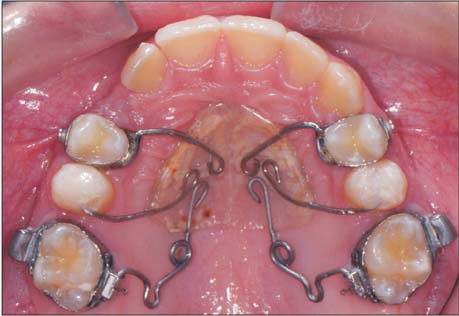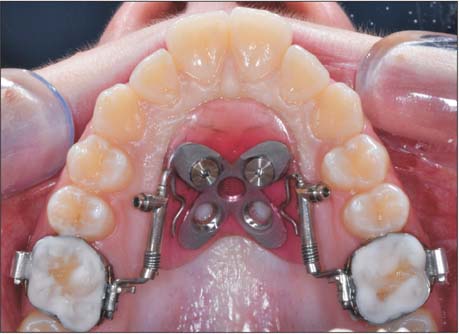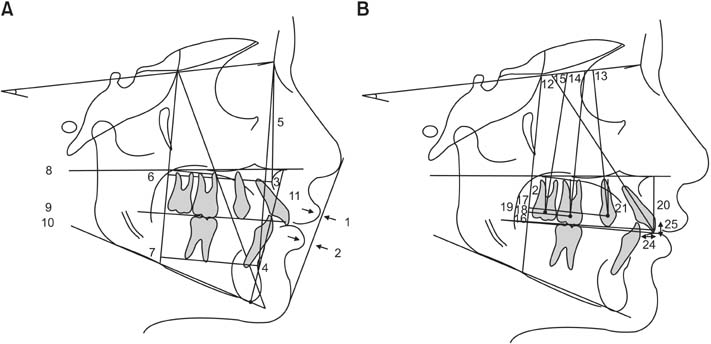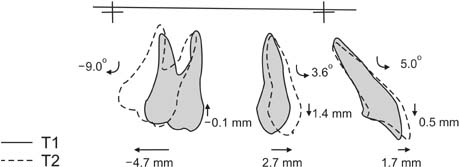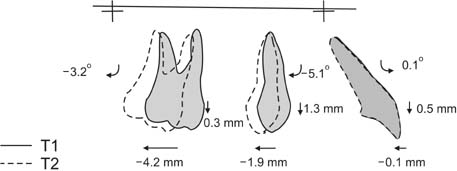Comparative evaluation of molar distalization therapy using pendulum and distal screw appliances
- Affiliations
-
- 1Postgraduate Programme in Orthodontics, School of Medicine, University of Insubria, Varese, Italy. mattiafontana16@gmail.com
- 2Postgraduate Programme in Orthodontics, University of Insubria, Varese, Italy.
- 3Department of Orthodontics, University of Insubria, Varese, Italy.
- 4Department of Orthodontics, School of Dental Medicine, University of Cagliari, Italy.
- KMID: 2400575
- DOI: http://doi.org/10.4041/kjod.2015.45.4.171
Abstract
OBJECTIVE
To compare dentoalveolar and skeletal changes produced by the pendulum appliance (PA) and the distal screw appliance (DS) in Class II patients.
METHODS
Forty-three patients (19 men, 24 women) with Class II malocclusion were retrospectively selected for the study. Twenty-four patients (mean age, 12.2 +/- 1.5 years) were treated with the PA, and 19 patients (mean age, 11.3 +/- 1.9 years) were treated with the DS. The mean distalization time was 7 months for the PA group and 9 months for the DS group. Lateral cephalograms were obtained at T1, before treatment, and at T2, the end of distalization. A Mann-Whitney U test was used for statistical comparisons of the two groups between T1 and T2.
RESULTS
PA and DS were equally effective in distalizing maxillary molars (4.7 mm and 4.2 mm, respectively) between T1 and T2; however, the maxillary first molars showed less distal tipping in the DS group than in the PA group (3.2degrees vs. 9.0degrees, respectively). Moreover, significant premolar anchorage loss (2.7 mm) and incisor proclination (5.0degrees) were noted in the PA group, whereas premolar distal movement (1.9 mm) and no significant changes at the incisor (0.1degrees) were observed in the DS group. No significant sagittal or vertical skeletal changes were detected between the two groups during the distalization phase.
CONCLUSIONS
PA and DS seem to be equally effective in distalizing maxillary molars; however, greater distal molar tipping and premolar anchorage loss can be expected using PA.
Keyword
MeSH Terms
Figure
Cited by 5 articles
-
Three-dimensional evaluation of tooth movement in Class II malocclusions treated without extraction by orthodontic mini-implant anchorage
Dler Ali, Hnd Mohammed, Seung-Hwan Koo, Kyung-Hwa Kang, Sang-Cheol Kim
Korean J Orthod. 2016;46(5):280-289. doi: 10.4041/kjod.2016.46.5.280.A three-dimensional finite element analysis of molar distalization with a palatal plate, pendulum, and headgear according to molar eruption stage
Ju-Man Kang, Jae Hyun Park, Mohamed Bayome, Moonbee Oh, Chong Ook Park, Yoon-Ah Kook, Sung-Seo Mo
Korean J Orthod. 2016;46(5):290-300. doi: 10.4041/kjod.2016.46.5.290.Maxillary molar derotation and distalization by using a nickel-titanium wire fabricated on a setup model
Jong Moon Jung, Young Joo Wi, Hyun Mo Koo, Min Ji Kim, Youn Sic Chun
Korean J Orthod. 2017;47(4):268-274. doi: 10.4041/kjod.2017.47.4.268.Biomechanical analysis of distalization of mandibular molars by placing a mini-plate: A finite element study
Myungsoon Park, Yonghyun Na, Minbong Park, Janghoon Ahn
Korean J Orthod. 2017;47(5):289-297. doi: 10.4041/kjod.2017.47.5.289.Comparison of treatment effects between the modified C-palatal plate and cervical pull headgear for total arch distalization in adults
Chong Ook Park, Noor Laith Sa'aed, Mohamed Bayome, Jae Hyun Park, Yoon-Ah Kook, Young-Seok Park, Seong Ho Han
Korean J Orthod. 2017;47(6):375-383. doi: 10.4041/kjod.2017.47.6.375.
Reference
-
1. Fontana M, Cozzani M, Caprioglio A. Non-compliance maxillary molar distalizing appliances: an overview of the last decade. Prog Orthod. 2012; 13:173–184.
Article2. Hilgers JJ. The pendulum appliance for Class II non-compliance therapy. J Clin Orthod. 1992; 26:706–714.3. Ghosh J, Nanda RS. Evaluation of an intraoral maxillary molar distalization technique. Am J Orthod Dentofacial Orthop. 1996; 110:639–646.
Article4. Byloff FK, Darendeliler MA. Distal molar movement using the pendulum appliance. Part 1: Clinical and radiological evaluation. Angle Orthod. 1997; 67:249–260.5. Byloff FK, Darendeliler MA, Clar E, Darendeliler A. Distal molar movement using the pendulum appliance. Part 2: The effects of maxillary molar root uprighting bends. Angle Orthod. 1997; 67:261–270.6. Chiu PP, McNamara JA Jr, Franchi L. A comparison of two intraoral molar distalization appliances: distal jet versus pendulum. Am J Orthod Dentofacial Orthop. 2005; 128:353–365.
Article7. Caprioglio A, Beretta M, Lanteri C. Maxillary molar distalization: Pendulum and Fast-Back, comparison between two approaches for Class II malocclusion. Prog Orthod. 2011; 12:8–16.
Article8. Cheng SJ, Tseng IY, Lee JJ, Kok SH. A prospective study of the risk factors associated with failure of mini-implants used for orthodontic anchorage. Int J Oral Maxillofac Implants. 2004; 19:100–106.9. Gracco A, Lombardo L, Cozzani M, Siciliani G. Quantitative cone-beam computed tomography evaluation of palatal bone thickness for orthodontic miniscrew placement. Am J Orthod Dentofacial Orthop. 2008; 134:361–369.
Article10. King KS, Lam EW, Faulkner MG, Heo G, Major PW. Vertical bone volume in the paramedian palate of adolescents: a computed tomography study. Am J Orthod Dentofacial Orthop. 2007; 132:783–788.
Article11. Cozzani M, Gracco A, Lombardo L, Siciliani G. Why, when and how distalizing maxillary molars. Ortognatod Ital. 2007; 14:21–27.12. Poggio PM, Incorvati C, Velo S, Carano A. "Safe zones": a guide for miniscrew positioning in the maxillary and mandibular arch. Angle Orthod. 2006; 76:191–197.13. Grec RH, Janson G, Branco NC, Moura-Grec PG, Patel MP, Castanha Henriques JF. Intraoral distalizer effects with conventional and skeletal anchorage: a meta-analysis. Am J Orthod Dentofacial Orthop. 2013; 143:602–615.
Article14. Kircelli BH, Pektaş ZO, Kircelli C. Maxillary molar distalization with a bone-anchored pendulum appliance. Angle Orthod. 2006; 76:650–659.15. Escobar SA, Tellez PA, Moncada CA, Villegas CA, Latorre CM, Oberti G. Distalization of maxillary molars with the bone-supported pendulum: a clinical study. Am J Orthod Dentofacial Orthop. 2007; 131:545–549.
Article16. Sar C, Kaya B, Ozsoy O, Özcirpici AA. Comparison of two implant-supported molar distalization systems. Angle Orthod. 2013; 83:460–467.
Article17. Kinzinger GS, Gülden N, Yildizhan F, Diedrich PR. Efficiency of a skeletonized distal jet appliance supported by miniscrew anchorage for noncompliance maxillary molar distalization. Am J Orthod Dentofacial Orthop. 2009; 136:578–586.
Article18. Cozzani M, Zallio F, Lombardo L, Gracco A. Efficiency of the distal screw in the distal movement of maxillary molars. World J Orthod. 2010; 11:341–345.19. Ludwig B, Glasl B, Kinzinger GS, Walde KC, Lisson JA. The skeletal frog appliance for maxillary molar distalization. J Clin Orthod. 2011; 45:77–84.20. Papadopoulos MA. Orthodontic treatment of Class II malocclusion with miniscrew implants. Am J Orthod Dentofacial Orthop. 2008; 134:604.e1–604.e16.
Article21. Wilmes B, Nienkemper M, Ludwig B, Kau CH, Pauls A, Drescher D. Esthetic Class II treatment with the Beneslider and aligners. J Clin Orthod. 2012; 46:390–398.22. Polat-Ozsoy O, Kircelli BH, Arman-Ozçirpici A, Pektaş ZO, Uçkan S. Pendulum appliances with 2 anchorage designs: conventional anchorage vs bone anchorage. Am J Orthod Dentofacial Orthop. 2008; 133:339.e9–339.e17.
Article23. Cozzani M, Pasini M, Zallio F, Ritucci R, Mutinelli S, Mazzotta L, et al. Comparison of maxillary molar distalization with an implant-supported distal jet and a traditional tooth-supported distal jet appliance. Int J Dent. 2014; 2014:937059.
Article24. Arnett GW, Gunson MJ. Facial planning for orthodontists and oral surgeons. Am J Orthod Dentofacial Orthop. 2004; 126:290–295.
Article25. Bolla E, Muratore F, Carano A, Bowman SJ. Evaluation of maxillary molar distalization with the distal jet: a comparison with other contemporary methods. Angle Orthod. 2002; 72:481–494.26. Enlow DH, Kuroda T, Lewis AB. The morphological and morphogenetic basis for craniofacial form and pattern. Angle Orthod. 1971; 41:161–188.27. Caprioglio A, Fontana M, Longoni E, Cozzani M. Long-term evaluation of the molar movements following Pendulum and fixed appliances. Angle Orthod. 2013; 83:447–454.
Article28. Dahlberg G. Statistical methods for medical and biological students. London, UK: Allen and Unwin;1940. p. 122–132.29. Houston WJ. The analysis of errors in orthodontic measurements. Am J Orthod. 1983; 83:382–390.
Article30. Angelieri F, Almeida RR, Almeida MR, Fuziy A. Dentoalveolar and skeletal changes associated with the pendulum appliance followed by fixed orthodontic treatment. Am J Orthod Dentofacial Orthop. 2006; 129:520–527.
Article
- Full Text Links
- Actions
-
Cited
- CITED
-
- Close
- Share
- Similar articles
-
- Three dimensional analysis of tooth movement using different types of maxillary molar distalization appliances
- The frog appliance for upper molar distalization: a case report
- Analysis of midpalatal miniscrew-assisted maxillary molar distalization patterns with simultaneous use of fixed appliances: A preliminary study
- Zygoma-gear appliance for intraoral upper molar distalization
- A three-dimensional finite element analysis of molar distalization with a palatal plate, pendulum, and headgear according to molar eruption stage

